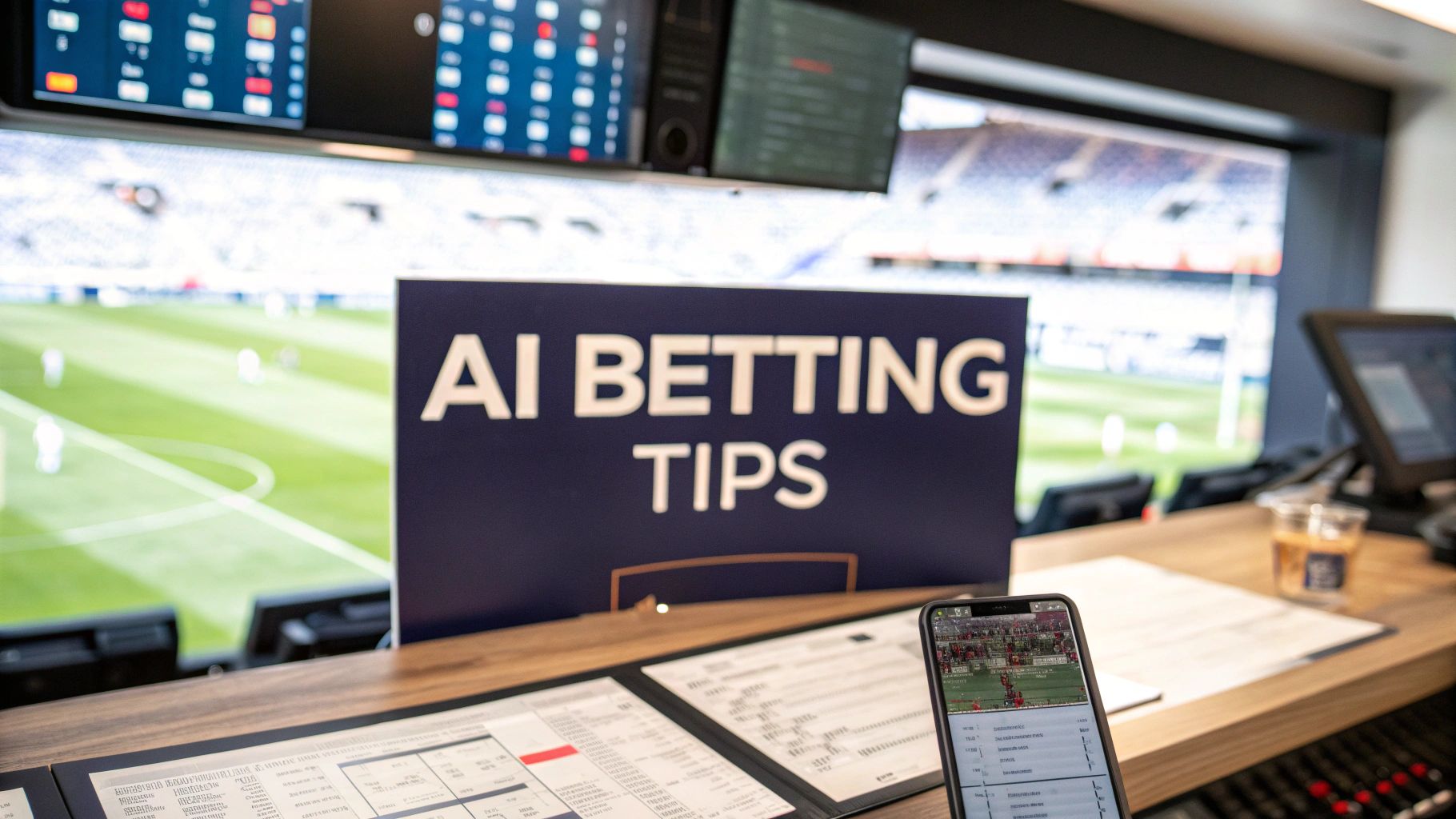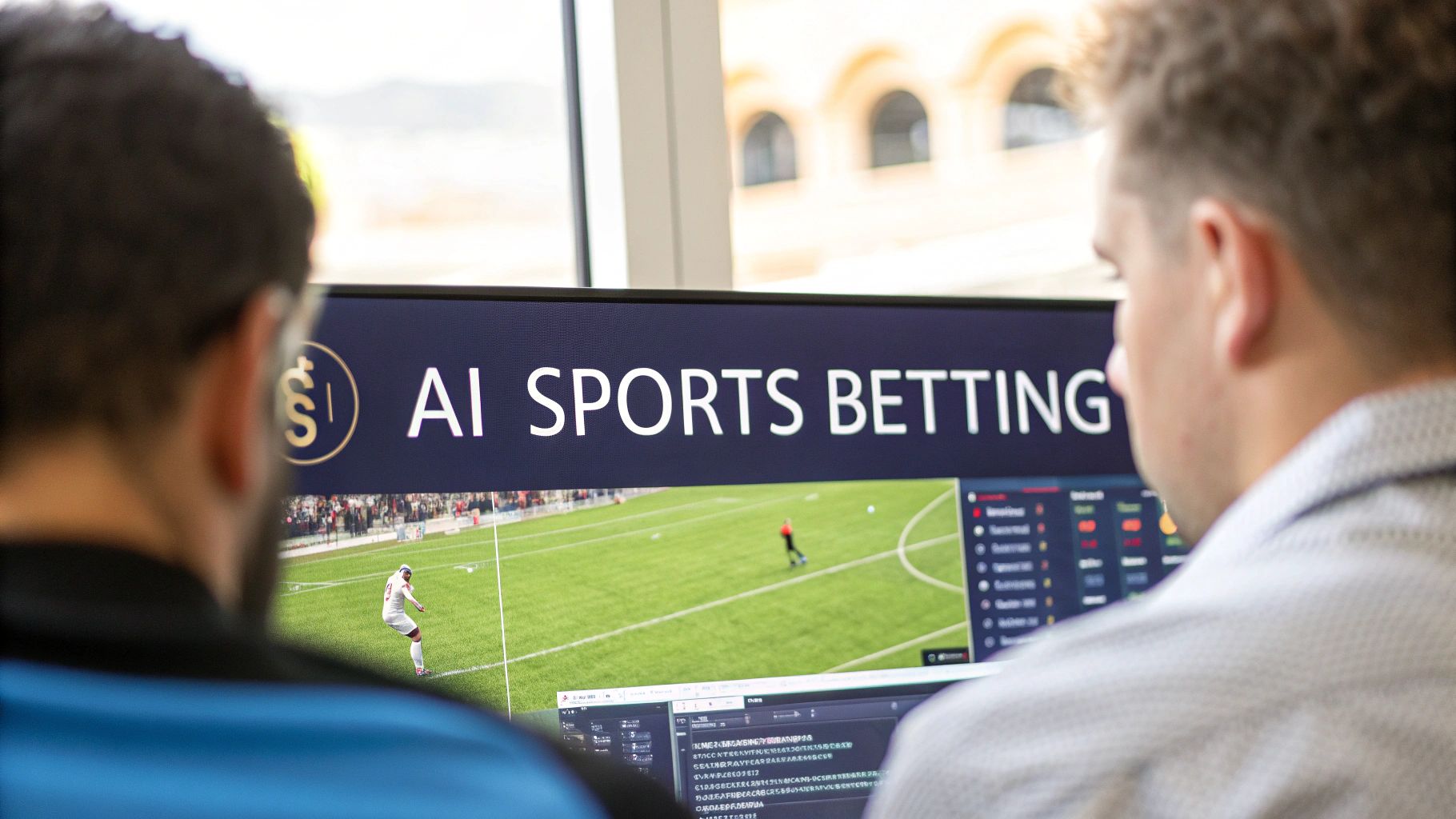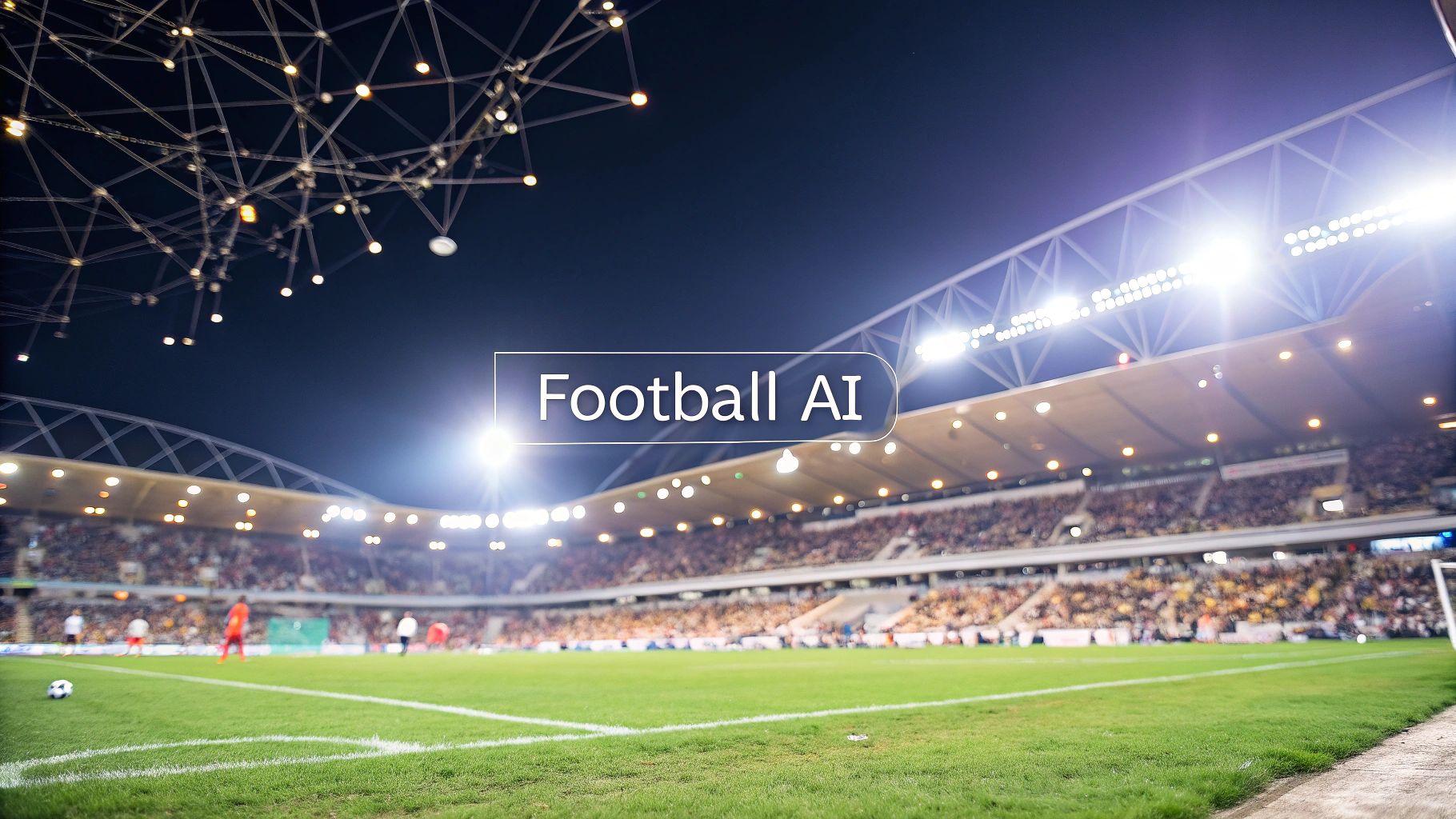
Football AI Prediction Data-Driven Match Insights
Unlock the power of football AI prediction. Learn how data models work, what fuels them, and how to use their insights to forecast match outcomes confidently.
A football AI prediction is, at its core, a forecast built on cold, hard data. It’s the result of powerful algorithms sifting through mountains of historical match data, player statistics, and tactical setups. This isn't just a sophisticated guess; it's a scientific approach. Machine learning models are trained to spot hidden trends and calculate the most likely outcomes, turning the art of prediction into a numbers game.
For fans and bettors, this technology is like having an elite analytical team in your corner, offering a significant edge.
The New Era of Football Forecasting
Welcome to the future of football analysis, where data science and the beautiful game have finally come together. The days of relying solely on a pundit's opinion, your own gut feeling, or even just the league table are numbered. We're now in an age where artificial intelligence can give us a much deeper, more detailed understanding of every single match.
This isn't about some magic crystal ball that perfectly predicts the future. A better way to think about it is as a super-analyst—one that has tirelessly studied every pass, tackle, and tactical tweak from thousands of past games to find patterns we could never see on our own.
The central idea behind a football AI prediction is to let a model crunch vast datasets and uncover the subtle connections that often decide a match. It quantifies everything from team form to defensive frailties with an objective eye. This shift from pure opinion to data-backed insight is a massive leap forward in how we look at the sport. It gives everyday fans and bettors access to the kind of high-level analysis that was once reserved for top clubs with their own data departments.
From Intuition to Data-Driven Insight
For decades, predicting a match was all about experience, intuition, and a bit of guesswork. That approach has its merits, of course, but it’s also prone to human error and bias. AI doesn’t replace that intuition; it strengthens it with a solid foundation of evidence, making forecasts more consistent and a whole lot more reliable. The real goal is to get past simple win/loss records and understand why a team performs the way it does.
This kind of technology is a game-changer, especially in leagues with their own unique character, like Romania's Liga I. Local rivalries, specific team dynamics, and tactical trends all play a huge part. A well-trained AI can pick up on these nuances by focusing on league-specific data, offering predictions that are far more accurate than what a generic, one-size-fits-all model could ever provide.
At its heart, AI in football is about probability, not certainty. It’s designed to calculate the likelihood of different results—a home win, a draw, or an away victory—giving you the clarity to weigh risk and opportunity like never before.
What AI Brings to the Pitch
Using AI for football predictions offers some clear advantages over the old ways. By juggling countless variables all at once, these systems create a remarkably complete picture of an upcoming game.
Here’s what you stand to gain:
- Objective Analysis: AI doesn't have a favourite team or get caught up in derby day hype. It follows the data, and only the data, which leads to completely impartial and logical conclusions.
- Pattern Recognition: It can spot complex patterns that would fly right over our heads. Think about things like how a team handles a high-pressing opponent or how they perform after a long trip for a midweek European match.
- Incredible Speed and Scale: An AI model can tear through thousands of data points from dozens of leagues in the blink of an eye—a job that would take a human analyst weeks to complete.
This guide is here to walk you through this fascinating world. We'll break down the tech in simple terms and show you exactly how to turn these powerful insights into a real, practical advantage.
How AI Prediction Models Actually Work
You don’t need a computer science degree to get your head around AI football prediction. Let's pop the bonnet and see what makes these systems tick. At its heart, an AI model is a system trained to spot patterns in vast amounts of historical data, all to make an educated guess about what’s going to happen next.
Think about teaching a computer to identify a winning team. You wouldn't just feed it the rulebook. Instead, you’d show it thousands of past matches – every goal, every card, every player substitution. This whole process is called machine learning, and it’s the bedrock of modern sports forecasting.
I like to think of an AI algorithm as a chef's secret recipe. The first draft might be pretty basic, but with every new ingredient (data from a new match), the chef tweaks and refines it. After tasting thousands of dishes (analysing countless games), that recipe becomes nearly perfect, able to produce a winning meal (an accurate prediction) time and time again.
The Building Blocks of Prediction
The real magic of AI is its power to put a number on things that used to be purely subjective. These models don't just see a "win" or a "loss"; they dissect every single action on the pitch into measurable data points. This creates a much richer, more nuanced picture of a team's true performance.
One of the most important metrics in this world is Expected Goals (xG). Instead of just tallying up shots, xG measures the quality of each attempt. It answers the question: based on thousands of similar shots from the past, what was the probability of that specific shot hitting the back of the net?
An AI model doesn’t have biases or favourite teams. It follows the data relentlessly, calculating probabilities based on evidence, not emotion. This objectivity is its greatest strength, transforming guesswork into a calculated science.
This simple yet powerful concept helps us quantify a team's attacking threat and defensive frailties. A team that consistently creates high-xG chances is probably going to start scoring goals, even if they've hit a recent unlucky patch. On the flip side, a team giving away lots of high-xG chances has a defence that's asking for trouble.
This infographic neatly shows the jump from relying on gut feeling to harnessing the analytical power of AI.
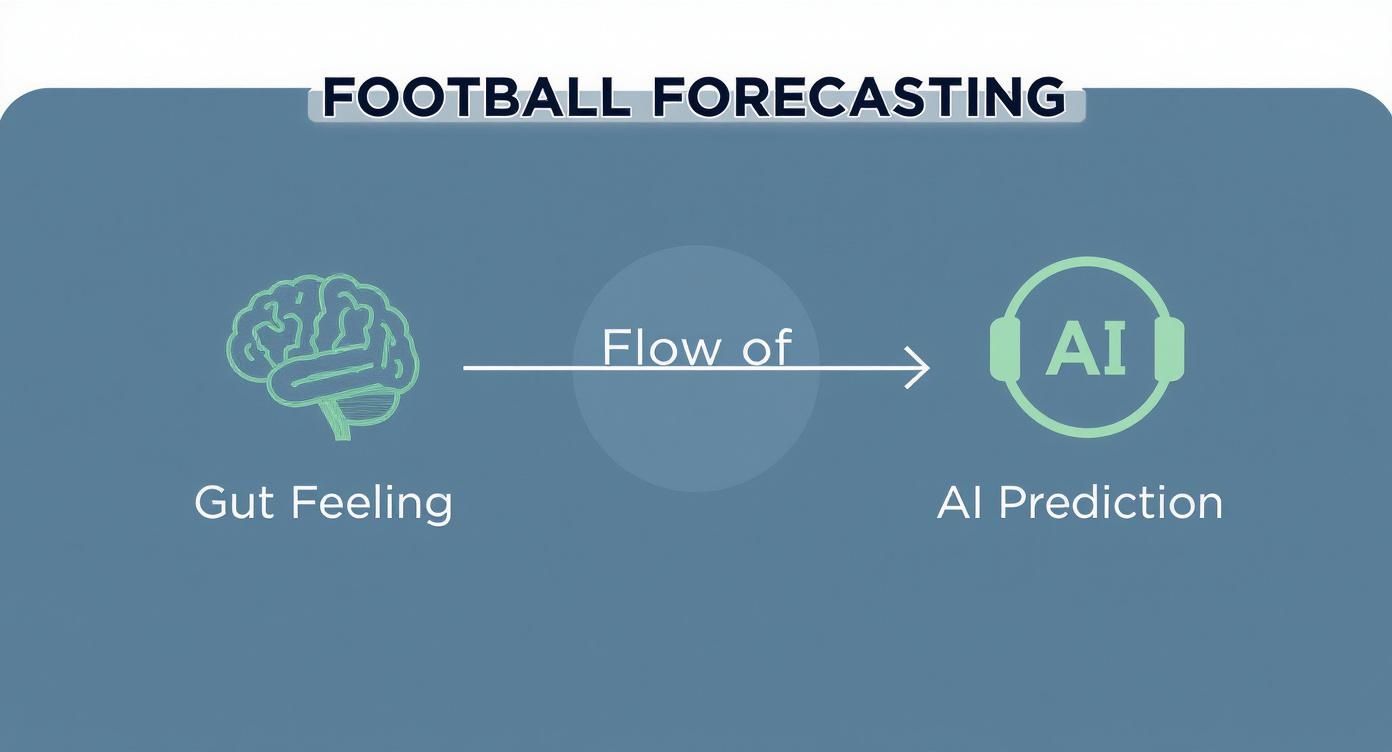
As you can see, AI isn't here to replace human insight. It's a sophisticated tool that builds on it, leading to much sharper forecasting.
From Simple Stats to Complex Networks
While xG is a fantastic starting point, the most advanced models go much, much deeper. They rely on complex structures called neural networks, which are loosely inspired by the way the human brain works. These networks are made up of interconnected nodes that weigh different pieces of information to reach a conclusion.
A modern neural network might be crunching hundreds of variables all at once:
- Team Form: How has the team performed in their last five matches? How does their home form compare to their away form?
- Player Statistics: Who are the key players on the pitch, and what kind of form are they in right now?
- Tactical Matchup: How does one team’s high-press style stack up against another’s counter-attacking approach?
- Contextual Factors: Are there major injuries or suspensions? What are the weather conditions like?
By processing all this information together, the model learns the incredibly complex relationships between all these different factors. It might figure out, for example, that a certain team's performance dips by 15% when their star midfielder is out, but only when they're playing against teams that use a specific formation.
This is the kind of detail that gives a football AI prediction its edge. These systems can even evolve; some of the more sophisticated models use multiple AI agents that collaborate to fine-tune their predictions. To see this in action, you can explore a deeper dive into how a multi-agent AI betting model functions.
Ultimately, the model spits out a probability forecast—a percentage chance for a home win, draw, or away win—that represents the combined wisdom drawn from thousands upon thousands of data points.
The Data That Fuels Winning Predictions
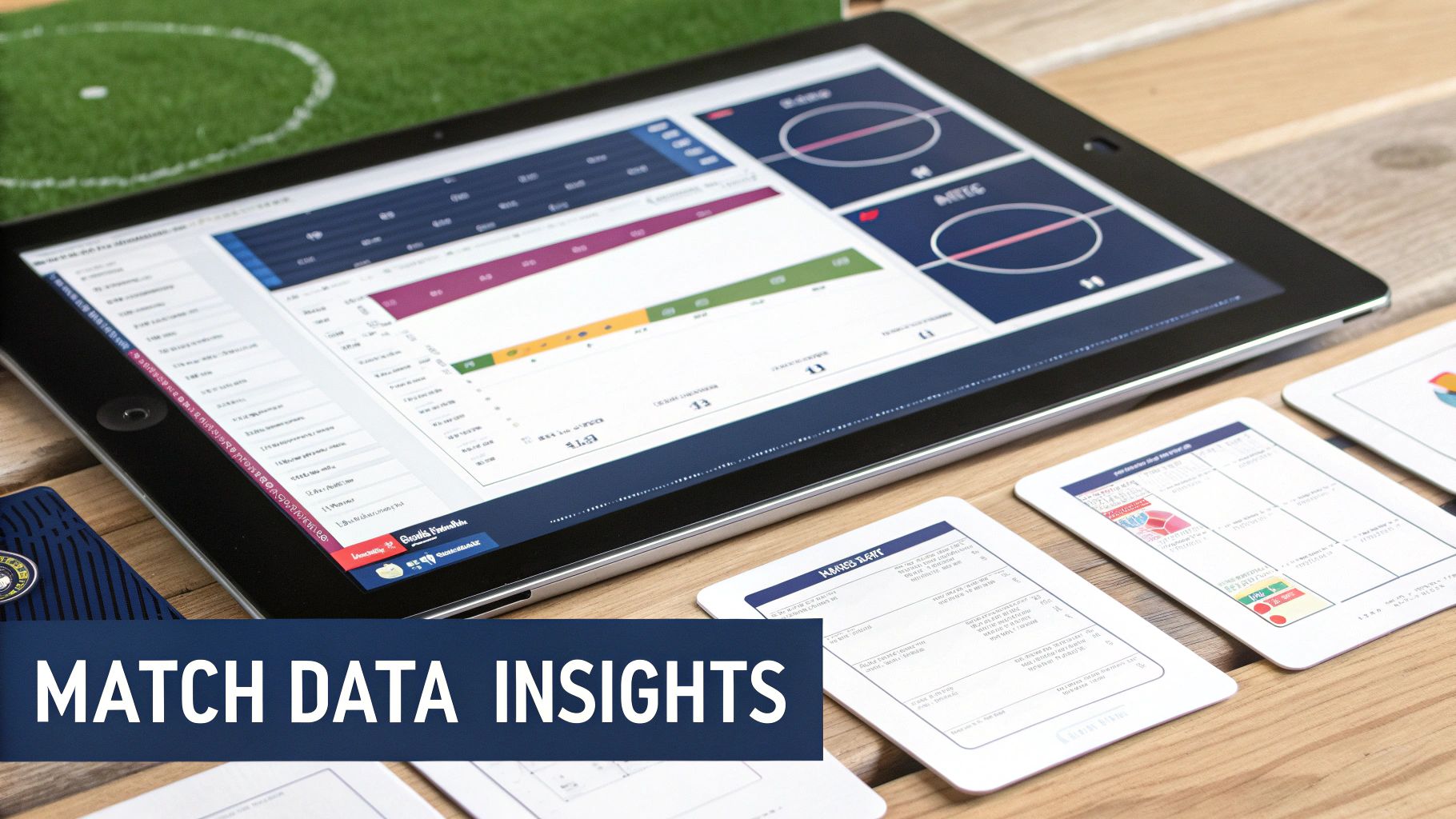
Think of an AI prediction model as a world-class football scout. Its insights are only as good as the information it gets. A scout who only glances at the final score will have a flimsy understanding of the game. But one who analyses every player's movement, every tactical tweak, and every pass? That scout sees the whole picture.
This is exactly how modern football AI prediction systems work. They thrive on a rich, diverse diet of data that goes miles beyond simple league tables. The quality, depth, and freshness of this data are the absolute bedrock of an accurate forecast. Without it, even the smartest algorithm is just taking a shot in the dark.
The Lifeblood of AI: Core Data Categories
To build a truly reliable prediction, an AI has to look at a match from every possible angle. It crunches huge datasets, sorting them to understand the hidden story behind every game. The most powerful models weave together several key types of information, creating a complete and dynamic view of what a team is capable of on any given Sunday.
To understand what goes into these predictions, it’s helpful to see how the models categorise the information they analyse.
Core Data Categories for AI Football Prediction Models
| Data Category | Examples | Why It Matters |
|---|---|---|
| Historical Match Data | Final scores, goals for/against, corners, bookings (yellow/red cards), possession stats. | This is the foundation. It tells the AI what has happened in the past, establishing a performance baseline and revealing long-term patterns. |
| Granular Player Metrics | Distance covered, passes completed, successful tackles, shots on target, Expected Goals (xG). | This moves beyond the team to the individual. It profiles each player's contribution, highlighting key playmakers and defensive liabilities. |
| Team Form and Streaks | Results of the last 5-10 matches, home vs. away performance, winning/losing streaks. | Momentum is huge in football. This data captures a team's current confidence, cohesion, and psychological state, which often defy league standings. |
| Contextual Factors | Key player injuries, manager changes, fixture congestion, weather conditions, team morale. | These are the crucial "off-the-page" variables. A star player's absence or a new manager's tactics can completely change a team's dynamic. |
Ultimately, a strong prediction isn't built on one superstar statistic. It's the result of combining thousands of data points—from player positioning to team morale—to create a multi-layered analysis that mirrors the true complexity of football.
Beyond the Basics: Weaving Data Together
The real magic happens when an AI doesn't just collect data, but starts to understand the relationships between different data points.
For instance, a model might learn that a specific team's xG (Expected Goals) value drops by 20% when their main creative midfielder is out, but only when they're playing away from home. This is the kind of granular insight that separates a generic guess from a truly sharp prediction. It’s about connecting the dots in ways a human analyst might miss.
To truly appreciate how this data impacts game outcomes, our guide on how player positioning and xG analytics work together is a great next step.
The precision of these models is already proving itself. In Romania, proprietary systems used by football tipsters have hit over 75% accuracy across more than 160 leagues globally, including Liga I. This isn't luck; it comes from deeply analysing xG trends, injury reports, and even the impact of new transfers. In the end, data is the engine of every credible football AI, turning the beautiful game's chaos into patterns we can actually understand.
All this theory about algorithms and data is great, but let's get down to brass tacks: does it actually work? When you’re talking about a football AI prediction, the only thing that matters is performance. To see how these concepts play out in the real world, we’ll zero in on a league we all know well: Romania's Liga I.
Focusing on a single league allows us to see how an AI model moves beyond generic, global data to really get a feel for local dynamics. Every league has its own unique rhythm, its own tactical flavour, and a competitive balance all its own. A truly smart AI has to learn these specific traits to offer up insights that are genuinely useful. It has to prove its worth on the pitch, not just in a lab.
Measuring Success in the Romanian League
The real acid test for any prediction model is how it holds up over time. In a league as fiercely competitive and unpredictable as Liga I, finding consistency is a huge challenge. And yet, this is where AI-powered systems are starting to show a remarkable knack for cutting through the noise to spot high-probability outcomes.
This isn't just lucky guesswork. It’s the direct result of models being meticulously fine-tuned on league-specific data. We’re talking about everything from old-school rivalries and head-to-head records to the current form of a star striker. This sharp focus lets the AI pick up on subtle patterns that a broader, one-size-fits-all model would almost certainly miss. The goal here is simple: build trust in the tech by showing its real-world impact in a setting fans know inside and out.
An AI's value isn't measured by one perfect prediction, but by its consistent ability to outperform chance and human intuition over the long run. In Liga I, this means identifying value where others see uncertainty.
So, what does that look like in practice? AI systems have had real success forecasting matches in the Romanian football pyramid. One leading Romanian AI football prediction model, for example, has hit an impressive win rate of around 66% across different betting markets, including final scores, 1X2 results, and goal totals. That’s a seriously impressive figure given the beautiful chaos of football, and it shows just how well these algorithms can weave together countless different factors. You can learn more about these metrics and see the AI in action.
A Closer Look at Liga I Dynamics
To really get how a football AI prediction is built for a specific league, you have to look at the data it's crunching. The Romanian Football Federation (FRF) website is a goldmine of official data, from player stats to team standings.
Here’s a glimpse of the official portal that acts as a core data source for any serious league analysis.
This official data is the ground truth. It’s the confirmed results, the player availability, and the fixture lists that form the skeleton of any trustworthy prediction model.
By processing this official info alongside more detailed performance metrics, an AI builds an incredibly rich picture of the league’s competitive landscape. It learns which teams are fortress-strong at home, which ones crumble against a low block, and which players are the linchpins of their team's success. This deep, local knowledge is precisely what allows the model to make such sharp forecasts. For anyone curious about how this translates to betting, our guide on AI sports betting strategies dives deeper into turning all this data into smart decisions.
From Data to Verifiable Results
So, what does this league-specific fine-tuning actually mean on match day? It means the AI can tackle nuanced questions that go way beyond a simple "who will win?" prediction.
- Tactical Matchups: How will CFR Cluj's rigid defence handle FCSB's free-flowing attack? The AI simulates the most likely game flow by analysing tactical data from their past meetings.
- Player Impact: If a key player like Florinel Coman is out, how much does that really hurt his team's chances? The model can actually quantify his impact on the team's overall performance.
- Form vs. History: A team is on a five-game winning streak but has a terrible record against their next opponent. Which matters more? The AI weighs recent form against long-term history to strike the right balance.
By relentlessly back-testing its predictions against thousands of past Liga I matches, the AI refines its own "understanding" of the league. It learns the unique personality of Romanian football. That's what allows it to give forecasts that aren't just statistically solid, but also completely in tune with the context of the league. This commitment to localised, provable performance is what separates a truly effective football AI prediction tool from all the noise.
A Practical Guide to Using AI Insights

Understanding the complex models behind a football AI prediction is one thing, but actually turning that raw data into a smart, practical decision is where the real skill comes in. This is where theory hits the turf. It’s not about blindly trusting an algorithm; it's about learning to speak its language and using its insights to sharpen your own footballing instincts.
The most common output you'll see from an AI is a set of probabilities. Instead of a simple "Team A wins," it will give you a breakdown of the chances for every outcome. For example, it might suggest a 60% chance of a home win, a 25% chance of a draw, and a 15% chance for the away team. Your first job is to get a feel for what these numbers are really telling you about the likely flow of the match.
Think of these percentages as the AI's cold, hard, data-driven opinion. It’s a baseline for your own analysis, completely free from the emotional bias and gut feelings that can so easily lead us astray.
Interpreting the AI's Language
Getting comfortable with AI predictions isn't about becoming a maths whizz. It's about recognising what the numbers are hinting at.
At its core, an AI prediction paints a picture of the upcoming game. To help you decode this, we've put together a quick guide on what the different types of AI outputs mean and how you can apply them to your own analysis.
Interpreting AI Prediction Outputs
| Prediction Type | What It Tells You | How to Use It |
|---|---|---|
| 1X2 Probabilities | The most direct forecast, giving the percentage chance for a Home Win (1), Draw (X), or Away Win (2). | Your primary indicator of the most likely match result. The foundation of your analysis. |
| Goal-Based Predictions | Forecasts for markets like Over/Under 2.5 goals. It signals the expected tempo and style of the game. | Helps you decide if the match will be a tight, defensive battle or an open, high-scoring affair. |
| Correct Score Likelihood | Probabilities for specific scorelines (e.g., 2-1, 1-0). These are less likely but highly specific. | Use these to spot strong trends or potential value in higher-odds markets when the AI is confident. |
The real trick is to weave these different outputs together. A high chance of a home win combined with a low goal prediction tells a very different story than one paired with a high goal forecast. This is how you start building a complete narrative of the match before a ball is even kicked.
Identifying Value in Predictions
The single most important skill to develop is spotting value. In simple terms, value exists when the AI’s calculated probability for an outcome is higher than the probability implied by the bookmaker's odds. This is the sweet spot where smart, data-informed decisions are born.
Think of it this way: The AI is your private analyst, giving you a second opinion. If a bookmaker's odds imply a team has a 50% chance to win, but your AI model crunches the numbers and puts their true chance at 65%, you’ve just found a potential value opportunity.
Of course, this is no guarantee of a win—football's far too unpredictable for that. But consistently finding and acting on these gaps is the very foundation of a disciplined, long-term strategy. It shifts your mindset from just hoping for a result to making mathematically sound choices over the long run.
For instance, statistical reviews of Romanian Liga I matches validated by AI often highlight these patterns. Data from certain match-ups showed Under 2.5 goals occurred in roughly 73% of games, while Over 1.5 goals was almost a certainty in others. You can explore more about these kinds of findings by checking out these insights on Liga I match outcomes.
AI as a Co-pilot, Not an Autopilot
It’s crucial to remember that a football AI prediction is a tool to support your analysis, not replace it. The sharpest bettors treat their AI as a co-pilot. They take its data-driven flight plan and overlay it with their own deep knowledge of the game—things like team morale, dressing-room tensions, or a manager’s tactical stubbornness that pure numbers can't always see.
Here's a simple, three-step way to blend AI into your routine:
- Start with the AI: First, check the AI's probabilities for a match. This gives you a completely objective starting point.
- Add Your Own Research: Now, layer on your own expertise. Have you noticed a star player looks out of form? Is there a fiery local derby atmosphere that stats can't quantify?
- Make an Informed Decision: Compare the AI's perspective with your own. If they align, your confidence can be high. If they clash, it’s a red flag to dig deeper and figure out why before making your move.
By taking this balanced approach, you get the best of both worlds: the immense power of data combined with the indispensable human touch. It’s a disciplined method that encourages responsible betting and helps build a sustainable strategy based on genuine insight.
The Future: Where AI Doesn't Just Predict the Game, It Changes It
What we’re seeing with football AI prediction right now is just the kick-off. As impressive as today’s pre-match analysis is, the real game-changer will be live, dynamic analysis that unfolds in real-time. The future isn’t about static predictions made before the first whistle; it’s about a constant stream of data that adapts with every moment of the match.
Picture this: you're watching a tense final, and the probability of a goal literally changes with every pass, every crunching tackle, every shot that flashes past the post. That's exactly where we're heading with real-time prediction models. These systems will be hooked directly into live event data, updating their forecasts second by second. When a star striker gets a yellow card or a manager makes a surprise tactical switch, the AI will instantly recalculate the odds, giving us insights that were pure science fiction just a few years ago.
From the Analyst's Desk to the Manager's Dugout
But why stop at just predicting winners and losers? The next logical leap is putting this immense analytical power right on the touchline, turning it into a secret weapon for coaches and tacticians.
Imagine what that could look like:
- Smarter Substitutions: An AI could analyse player fatigue data against the opponent's shifting formation and whisper in the manager's ear: "Now is the perfect moment to make that change."
- Deadly Set-Pieces: It could pinpoint the weak link in the other team's defence on a corner kick, recommending the exact delivery zone and the best player to target.
- Calculated Risks: The system could instantly weigh up the risk-reward of a cynical foul to break up play versus the danger of conceding a goal-scoring chance.
This isn't about replacing a manager's gut feeling. It’s about supercharging that intuition with a staggering amount of data-driven evidence. We're talking about a future where every big decision is backed by millions of simulated outcomes, giving teams a critical advantage when it matters most.
The end goal is a perfect conversation between the pitch and the algorithm. The AI won't just tell you what might happen; it will actively help you shape the outcome by feeding actionable intelligence straight to the sidelines.
The Human Element: Weaving in Biometric Data
The next massive breakthrough will be adding a much deeper layer of player data. Today’s models are great with performance stats like xG and pass completion, but the future is about blending that with biometric data from sophisticated wearable sensors.
Suddenly, the AI won't just know what a player is doing, but how their body is holding up under the strain of the game.
- Spotting Fatigue: By tracking things like heart rate variability and muscle oxygen levels, an AI could predict when a player is hitting the "red zone" and is more likely to make a mistake or get injured.
- Preventing Injuries: Advanced models could analyse tiny, almost imperceptible changes in a player's running style to flag a potential muscle strain days before it becomes a season-ending injury.
By fusing tactical information with live biological feedback, a football AI prediction becomes incredibly personal and far more accurate. It builds a complete, 360-degree view of team performance, factoring in the physical and even mental state of every player. This isn't just about making the game more predictable; it's about making it safer for the athletes. The technology is moving at a breakneck pace, and for anyone involved in the beautiful game, it’s a sign that football is about to get smarter, sharper, and more fascinating than ever before.
Frequently Asked Questions
Diving into the world of football AI prediction always sparks a few questions. It's a powerful bit of kit, but knowing what it can and can't do is the key to getting the most out of it. Let's tackle some of the most common queries.
How Accurate Are Football AI Predictions?
This is the big one, isn't it? The honest answer is that it varies. No model on earth can promise 100% accuracy – football is just too chaotic for that. Anyone telling you otherwise is selling snake oil.
However, the best AI systems consistently out-punch basic stats and gut feelings over the long haul. We're seeing top-tier models hitting win rates of 66% or even higher in certain betting markets. The real magic isn't about being right every time; it's about being right more often and, crucially, spotting value where the bookies might have priced an outcome incorrectly. Success is measured by long-term profitability, not a perfect streak.
What Data Is Used to Make These Predictions?
An AI is only as smart as the data it's fed. For football, that means a staggering amount of information gets crunched for every single match.
- Historical Performance: We’re talking years of results, goals scored, corners, and cards.
- Player Metrics: It goes deeper than just goals. Think Expected Goals (xG), passing accuracy, and even how much ground a player covers.
- Team Form: Is a team on a hot streak? Do they crumble away from home? The model knows.
- Contextual Factors: This is the crucial stuff – injuries to key players, suspensions, or even a new manager in the dugout.
By weaving all these threads together, the AI builds a ridiculously detailed picture of each team's potential before a ball is even kicked.
Think of an AI prediction as a powerful tool to sharpen your own judgement, not replace it. The smartest approach is to combine the AI's cold, hard numbers with your own knowledge of things a machine can't measure, like the white-hot atmosphere of a local derby.
Is This the Same as Traditional Sports Analysis?
Not quite, though they're aiming for the same goal. A traditional pundit relies on experience, recent form, and their own expert interpretation. It’s an art form, but it can be coloured by personal biases and popular narratives.
A football AI prediction, on the other hand, is completely objective. It doesn't have a favourite team and couldn't care less about media hype. It sifts through massive datasets to find hidden patterns a human might miss, calculating the odds with pure mathematical precision. It's like adding a data scientist to your team of expert pundits.
Ready to stop guessing and start making data-driven decisions? Let OddsHaven be your analytical co-pilot. Our AI delivers daily, high-confidence picks with clear reasoning, helping you spot value and build smarter parlays. Transform your strategy today at https://www.oddshaven.ai.
Ready to Start Winning?
Join OddsHaven and get instant access to AI-powered predictions with an 87% win rate on high-confidence picks
Try OddsHaven Free for 5 Days